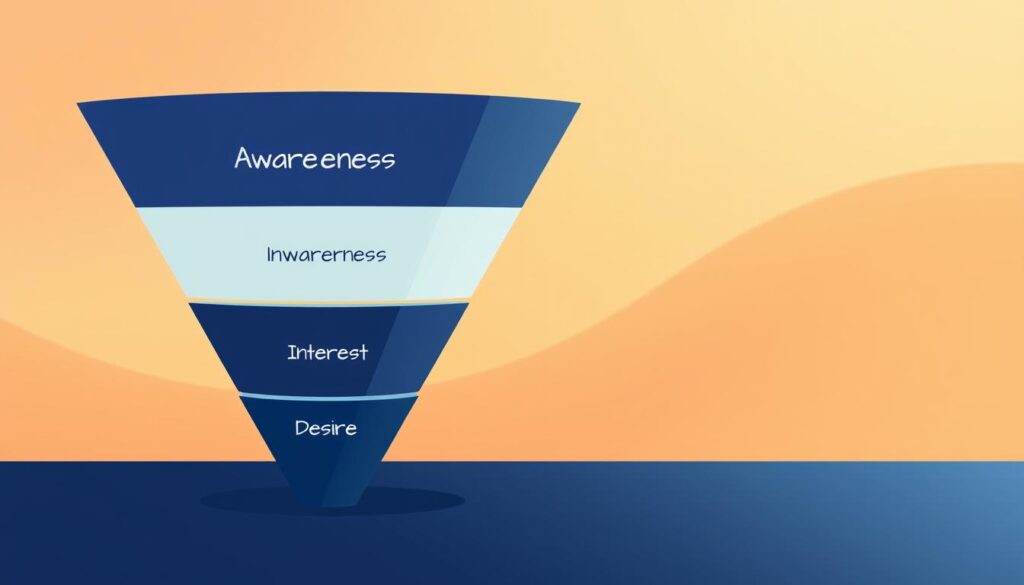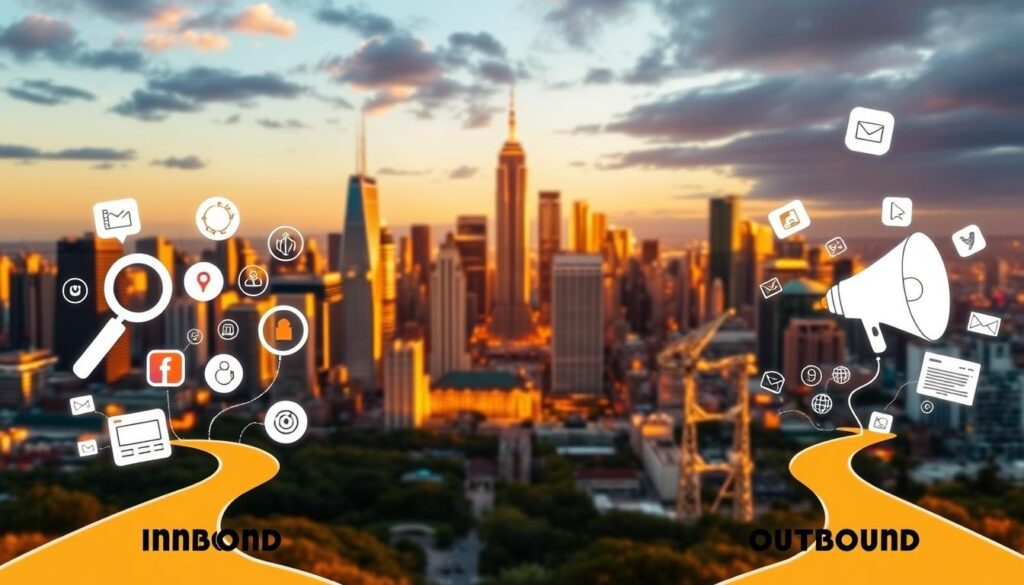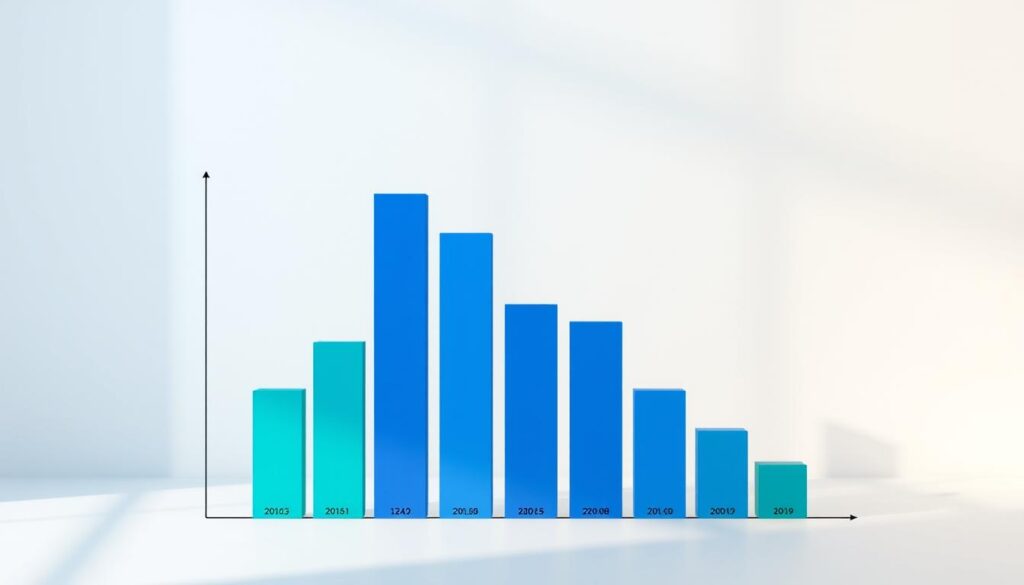Ever wonder why some businesses effortlessly attract potential customers while others struggle? The secret lies in mastering lead generation—a strategic process that turns strangers into loyal buyers.
Gone are the days of cold calls and spam emails. Modern tactics focus on value-driven content that builds trust. Think blogs, webinars, and free tools—like HubSpot’s lead gen software—to capture interest organically.
Here’s the kicker: 63% of marketers say this is their toughest challenge. But with a clear sales funnel and teamwork between departments, boosting conversion rates becomes achievable. Ready to dive deeper?
Introduction to Lead Generation
Nearly 70% of businesses miss opportunities due to weak lead management. Without a clear funnel, marketing efforts rarely translate into revenue. A strong sales team relies on qualified prospects—not just raw contacts.
Why does this gap exist? For B2B products services, 30% of deals take 1–3 months to close. Yet, 68% of companies lack structured nurturing. The fix? Prioritize quality over quantity.
Effective lead generation strategies filter out mismatched prospects early. Automation tools, like those Amazon Ads uses, map customer journeys to streamline conversions. B2C moves faster, but B2B demands patience—48% of leads need extended nurturing.
Ignore these steps, and resources drain fast. Poorly managed leads cost time and trust. Invest in smart tools, and watch efficiency soar.
What Is a Lead?
Not all prospects are created equal—some show stronger buying signals than others. A lead is any contact who engages with your brand digitally, like downloading content or requesting a demo. These actions reveal interest, but not all are sales-ready.
Marketing Qualified Lead (MQL)
MQLs interact with top-funnel content but need nurturing. For example, 35% of ebook downloaders eventually buy. Tools like G2 reviews help track their journey from interest to intent.
Sales Qualified Lead (SQL)
SQLs request demos or pricing—they’re primed for sales teams. CRM software providers see 22% conversion rates post-demo. Scoring factors include budget and timeline.
Product Qualified Lead (PQL)
Freemium users become PQLs after experiencing value. Dropbox’s model converts trial users by highlighting premium features. Product engagement here outweighs cold outreach.
Service Qualified Lead
Zendesk prompts upgrades when users hit usage limits. This service-based approach targets existing customers with expansion opportunities.
Prioritize leads using BANT criteria (Budget, Authority, Need, Timeline). Filtering early saves resources and boosts conversions.
What Is Lead Generation?
Business growth thrives on turning visitors into paying customers—here’s how. Strategic methods blend attraction and conversion, from blogs to landing pages. Each piece works together to build trust and drive action.
- CTAs: Clear buttons like “Get Started” boost clicks by 47%.
- Landing pages: Optimized designs convert 25% better than generic sites.
- Lead magnets: Free tools or ebooks exchange value for contact details.
Organic and paid channels serve different goals:
- Organic: SEO and content marketing attract long-term traffic.
- Paid: Ads on Meta or Google yield faster but costlier results.
SEMrush analytics reveal top-performing campaigns. For example, B2B industries average $50 per lead, while eCommerce hits $30. HubSpot’s CRM integration lifted sales by 40% through smoother handoffs.
Always prioritize GDPR compliance. Secure consent before collecting data to protect your brand reputation. Transparency builds trust—and higher conversions.
Why Your Business Needs Lead Generation
A 133% revenue boost separates companies with and without lead generation systems. Mature processes turn interest into sales faster, while others waste $1.6B annually chasing mismatched audiences.
Speed matters. Proper strategies shorten sales cycles by 23%, according to Forrester. Nurtured leads also show 28% lower churn rates, protecting long-term business growth.
Account-based sales marketing sharpens focus. Instead of broad campaigns, teams target high-value customers with personalized offers. This approach lifts lifetime value by 40% in B2B sectors.
Competitive intelligence refines outreach. Analyzing rival gaps helps tailor messaging. The result? Higher conversions and leaner budgets—proof that smart prospecting pays off.
How Lead Generation Works: The 5-Step Process
Transform curious visitors into loyal buyers with a structured approach. Each stage refines prospects until they’re ready to purchase. Here’s how top brands streamline their lead generation process.
1. Attracting Potential Leads
Drive traffic using content marketing and SEO. Blogs ranking for terms like “best CRM tools” attract 300% more visitors. Tools like Ahrefs pinpoint high-intent keywords to fuel website growth.
2. Capturing Lead Information
Convert visitors with optimized landing pages. Unbounce templates achieve 40% higher sign-ups by minimizing form fields. Offer value—like free demos—to encourage sharing contact details.
3. Nurturing Relationships
Automated email sequences keep prospects engaged. Drip campaigns with personalized tips boost conversions by 80%. Toyota’s post-survey follow-ups increased dealership visits by 35%.
4. Qualifying Leads
AI scoring models prioritize ready-to-buy contacts. Factors like budget and engagement level predict sales potential. This step saves teams 20+ hours weekly by filtering mismatched leads.
5. Converting Leads to Customers
Seal deals with CRM-powered handoffs. Salesforce integrations reduced close times by 30% for SaaS companies. Tailored offers—based on past behavior—lift conversion rates by 22%.
Mastering this lead generation process turns friction into growth. Start small, track metrics, and scale what works.
The Lead Generation Funnel Explained
Understanding the journey from casual visitor to loyal customer is key to successful marketing. A well-structured funnel guides your audience through three critical stages, ensuring no potential buyer slips through the cracks.

Top of the Funnel (TOFU)
TOFU focuses on awareness. Buzzfeed-style quizzes or viral blog posts attract 10K+ leads by sparking curiosity. Tools like HubSpot track engagement, helping tailor content to broad audience interests.
Middle of the Funnel (MOFU)
Here, prospects compare solutions. Webinars with 65% attendance rates or comparison guides nurture intent. LinkedIn’s Content Marketing Institute model shows how targeted campaigns deepen relationships.
Bottom of the Funnel (BOFU)
BOFU drives decisions. Free trials or demo requests convert hesitant buyers. Marketo’s scoring system identifies ready-to-purchase leads, streamlining handoffs to sales teams.
Google Analytics reveals multi-channel touchpoints, while optimized landing page designs boost conversions. Mastering this funnel turns scattered efforts into a revenue-driving machine.
How to Generate Leads: 6 Proven Strategies
Businesses that consistently attract high-quality prospects don’t rely on luck—they use proven tactics. The right mix of content, social media, and targeted campaigns turns interest into revenue. Here’s how top brands like Dropbox and Slack do it.
1. Create Compelling Content
Interactive tools like calculators or quizzes boost engagement. Ryan Robinson’s AI assistant case study showed a 120% increase in sign-ups with value-driven blog content. Templates from Canva’s library simplify design-heavy assets.
2. Leverage Email Marketing
Segmented campaigns achieve 25% higher open rates. Personalize subject lines and timing—tools like Mailchimp automate this process. Nurture leads with educational series instead of hard sells.
3. Optimize Social Media
LinkedIn’s lead gen forms cut cost-per-lead by 40%. Share case studies and polls to spark conversations. Consistent posting schedules keep brands top-of-mind.
4. Offer Product Trials
Slack’s freemium model converts users by showcasing premium features. Limited-time trials create urgency. Analyze usage data to identify upsell opportunities.
5. Ask for Referrals
Dropbox grew 390% by rewarding users for sharing invites. Incentivize referrals with discounts or exclusive access. Happy customers are your best advocates.
6. Use Paid Ads
Google’s Local Service Ads drive 50% more conversions than standard PPC. Retarget website visitors with dynamic ads. A/B test creatives to refine messaging.
These strategies work best when combined. Track metrics like conversion rates to double down on what generates leads efficiently.
Tips for Effective Lead Capture
Simple tweaks to your lead capture process can double conversions. Start with streamlined forms—three fields convert 25% better than five. Less friction means more submissions.

Chatbots boost engagement by 35%. They answer questions instantly, guiding visitors to sign up. Exit-intent popups recover abandoning users—time them for peak impact.
Your company must prioritize GDPR compliance. Clearly explain data usage to build trust. Progressive profiling gathers details over time, avoiding overwhelming forms.
- Trust badges increase form completion by 28%. Display security logos or testimonials.
- Mobile-friendly designs are non-negotiable. Test website forms on all devices.
- A/B test headlines, colors, and CTAs. Small changes yield big results.
Make sure popups trigger at the right moment. Offer value—discounts or free trials—to incentivize action. Track metrics to refine your strategy continuously.
How to Qualify Leads for Maximum Conversion
High-performing sales teams don’t chase every lead—they qualify ruthlessly. The BANT framework (Budget, Authority, Need, Timeline) weeds out mismatched prospects early. Focus on contacts ready to make purchase decisions.
Advanced methods like MEDDIC (Metrics, Economic Buyer, Decision Criteria) deepen qualification. Salesloft’s conversation intelligence tools analyze calls for buying intent. Key signals include:
- Budget: Can they afford your solution?
- Authority: Are they the decision-maker?
- Urgency: Timeline for implementation.
Predictive analytics, like Salesforce Einstein, scores leads automatically. CRM workflows flag high-potential customer profiles. Discovery call scripts should uncover pain points—80% of deals go to vendors who listen first.
Apply the 80/20 rule: 20% of leads sales teams qualify drive 80% of revenue. Track metrics like lead-to-close ratios to refine criteria. Less chasing, more closing.
Inbound vs. Outbound Lead Generation
Modern businesses choose between two paths to attract prospects: pulling them in or reaching out. Inbound tactics cost 62% less per lead, making them a favorite for budget-conscious teams. Outbound, however, speeds up pipeline growth with direct outreach.

LinkedIn InMail vs. Content Syndication
Outbound relies on tools like LinkedIn InMail, averaging an 8% response rate. Inbound leverages search engine-optimized content syndication—blogs and whitepapers attract organic traffic over time.
Account-Based Marketing vs. Broad Campaigns
Outbound excels with hyper-targeted sales marketing, like ABM. Inbound casts a wider net, nurturing leads through educational content. SEMrush (inbound) and ZoomInfo (outbound) streamline these strategies.
- GDPR Compliance: Outbound requires explicit consent; inbound builds trust transparently.
- Referral Programs: Dropbox grew 390% by incentivizing shares—a hybrid tactic.
- Trade Shows: Lead retrieval systems blend both methods for high-intent prospects.
Balance both approaches based on goals. Inbound fuels long-term growth, while outbound accelerates immediate results.
Lead Generation Tools to Streamline Your Process
Cutting-edge tools eliminate guesswork, helping teams focus on high-value prospects. Platforms like HubSpot combine CRM, email automation, and analytics into one system. This all-in-one approach reduces friction and scales efforts effortlessly.
Visitor tracking transforms anonymous traffic into actionable leads. Leadfeeder reveals which companies visit your site, empowering targeted follow-ups. Pair this with optimized forms—three fields convert 30% better than lengthy ones.
Marketo’s engagement scoring prioritizes ready-to-buy contacts. Drift’s chatbots capture leads 24/7 by answering FAQs instantly. Automation tools like Zapier connect apps, routing prospects to sales teams without manual work.
Clearbit enriches contact data with firmographics, while Hotjar’s heatmaps show where visitors engage. Sync Calendly with Salesforce to streamline meeting scheduling. These tools turn chaos into a seamless workflow.
Cross-promote via blog content and social media integrations. Track performance with dashboards to double down on what works. The right tech stack isn’t a luxury—it’s the backbone of scalable growth.
Lead Generation Statistics You Should Know
Numbers don’t lie—understanding key metrics separates thriving brands from stagnant ones. A staggering 85% of B2B marketers cite prospecting as their toughest hurdle. Yet, those who track performance data outperform peers by 3x.

Industry benchmarks reveal stark contrasts. Average cost-per-lead ranges from $43 (eCommerce) to $198 (legal services). Mobile leads convert 70% faster than desktop, emphasizing responsive design.
Sales teams leveraging video content see a 27% lift in engagement. Chatbots qualify leads with 58% accuracy, slashing manual screening time. Personalized emails drive 6x higher conversion rates than generic blasts.
- Social selling: LinkedIn generates 3x more leads than other platforms.
- ABM impact: Targeted accounts yield 45% larger deal sizes.
- Trust signals: 64% of prospects research a brand before engaging.
Data-driven strategies cut waste and amplify ROI. Prioritize metrics aligning with your goals, and refine tactics continuously.
Lead Conversion Rates and Benchmarks
While many businesses focus on attracting leads, the real challenge lies in converting them effectively. Top performers achieve an 11.7% conversion rate, dwarfing the 2.4% industry average. The gap highlights the importance of optimizing every funnel stage.
SaaS companies see 3–5% of free trial users *make purchase* decisions. Ecommerce brands combat cart abandonment with exit-intent popups, recovering 15% of lost sales. Speed matters—leads contacted within 5 minutes convert 8x more.
Multi-touch attribution models reveal which channels drive decisions. CRM analytics track pipeline velocity, showing how fast deals close. For example, shorter sales cycles often correlate with higher win rates.
Win/loss analysis uncovers gaps in service or pricing. ROI calculators help teams prioritize high-value prospects. Tools like HubSpot automate these metrics, turning raw data into actionable insights.
- Response time: 78% of buyers choose the first vendor to reply.
- Personalization: Tailored demos boost conversions by 22%.
- Follow-ups: 80% of sales require 5+ touches.
Benchmarking against top performers reveals improvement opportunities. Track, test, and refine—conversion excellence is a continuous journey.
Emerging Lead Generation Trends
The landscape of attracting potential buyers is evolving faster than ever. AI-powered scoring now drives 67% more adoptions year-over-year, proving that automation is no longer optional.

Conversational platforms like Drift and Intercom personalize interactions in real time. These tools analyze chat histories to predict buyer intent, boosting engagement by 40%.
Predictive analytics refine how teams prioritize their audience. Platforms like Salesforce Einstein score leads based on behavior, trimming wasted effort.
Video prospecting cuts through inbox noise. Loom’s personalized clips achieve 3x higher response rates than emails alone. Interactive formats—AR demos or VR tours—deepen immersion.
Voice search optimization is critical. With 55% of households using smart speakers, optimizing for natural queries wins attention.
Privacy-first strategies build trust. Zero-party data collection, like Typeform surveys, replaces invasive tracking. User-generated content (UGC) campaigns leverage testimonials for authenticity.
Adapting to these trends ensures your pipeline stays full without sacrificing efficiency. Test one or two methods, measure results, and scale what works.
Common Lead Generation Mistakes to Avoid
Many businesses unknowingly sabotage their own success with avoidable errors. A staggering 65% struggle with poor lead quality—often due to these missteps.
Neglecting lead scoring wastes time on unqualified prospects. Make sure your team prioritizes contacts with high conversion potential. CRM tools automate this process.
Delayed follow-ups kill momentum. Respond within 24–48 hours or lose 78% of leads. Automated emails keep your company top-of-mind.
- Mobile-unfriendly forms drop conversions by 35%. Test designs on all devices.
- Over-relying on one channel limits reach. Diversify with social, email, and SEO.
- Ignoring recycled leads misses 30% of potential sales. Nurture past contacts.
Sales-marketing misalignment creates friction. Regular syncs ensure shared goals. Highlight your product’s benefits consistently across teams.
No optimization stagnates results. A/B test landing pages and CTAs monthly. Make sure data drives decisions, not guesses.
Conclusion
Mastering lead generation transforms how your business grows. Follow the five-step process—attract, capture, nurture, qualify, and convert—to build a steady pipeline. Automation tools boost efficiency, with companies seeing 451% more qualified prospects.
Optimization never stops. Test landing pages, refine CTAs, and track metrics like conversion rates. AI-powered scoring and chatbots are reshaping outreach, making personalization scalable.
Start small with HubSpot’s free CRM kit. Focus on high-intent leads, and prioritize speed—78% of deals go to the fastest responders. Ready to refine your strategy? Audit your funnel today.
For deeper learning, explore case studies on AI-driven prospecting and conversion benchmarks. Consistent effort turns strangers into loyal customers.


